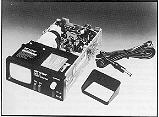|
Microvision TV1A/MON1A
Sinclair Radionics, 1976
After
its abortive launch in 1966, the Microvision
miniature television disappeared into Sinclair's development
laboratory for another decade before finally making it to
the market. Still advertised as the Microvision, though formally
called the TV1A to distinguish it from its prototype
predecessor, the device was first launched at the end of 1976
in the United States.
The design of the TV1A was
significantly different from that of the prototype. AEG Telefunken
of Germany had developed a miniature cathode ray tube exclusively
for Sinclair, while the bulk of the electronics had been custom-designed
for Sinclair Radionics. In hindsight, the TV1A was a notable
departure for the company, which hitherto had depended on
adapting existing components; now it was developing its own
hardware. This was a significant step forward, paving the
way for the much more ambitious hardware development programmmes
of the 1980s.
Also unusually for Sinclair,
normally an unashamed populist, the TV1A was aimed initially
at the business / exective market with a cost of $400. Weighing
some 26 ounces, this made it - ounce for ounce - more costly
than solid silver.
The device was 4" wide,
6" deep, and 1.5" high, powered either by rechargeable
batteries or from the mains. The black-and-white picture could
be viewed comfortably from about a foot away. It functioned
on VHF and UHF bands and was the first-ever multi-standard
receiver, which meant that it could be used in nearly every
foreign country as long as the country used one of the three
major TV standards.
Unfortunately for Sinclair,
demand outstripped supply (not for the first or the last time)
and by the time a sufficient number of TV1As were coming off
the production line at the break-even point of 4,000 a month,
demand had slumped and unsold stock built up rapidly. The
backlog of 12,000 TV1As was eventually resolved by selling
them off cheaply. This resulted in a £480,000 loss for
Sinclair at a time when the company could ill afford it.
 Sinclair
himself was certain that the "new and improved"
TV1B - a more efficiently designed model, launched
in the autumn of 1978 - would take off, causing demand to
spiral and saving the company. The TV1C and TV1D
were, respectively, US and European variants of the TV1B,
adapted to work with the local television systems. A mini-monitor,
the Mon1A (right), was also
produced, based on the TV1A hardware and housed in a very
similar case. Sinclair
himself was certain that the "new and improved"
TV1B - a more efficiently designed model, launched
in the autumn of 1978 - would take off, causing demand to
spiral and saving the company. The TV1C and TV1D
were, respectively, US and European variants of the TV1B,
adapted to work with the local television systems. A mini-monitor,
the Mon1A (right), was also
produced, based on the TV1A hardware and housed in a very
similar case.
In the event, the gamble failed. The TV1B/C/D
was the last product from the Sinclair Radionics stable. In
July 1979, the National Enterprise Board - Sinclair's government
backers - finally got fed up and pulled the plug on the company.
Sinclair received a £10,000 "golden handshake"
and set up Science of Cambridge instead. The rights to the
TV1B were sold to Binatone, but the product was soon dropped.

Back
to top
© Chris Owen 1994-2003
|